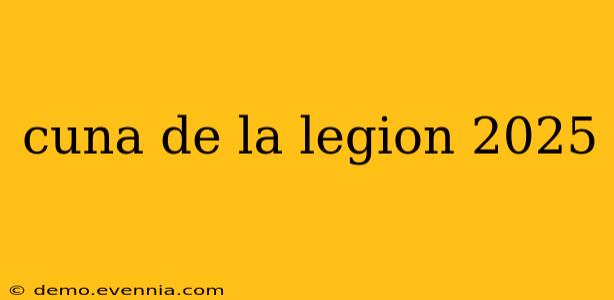The "Cuna de la Legión" (Cradle of the Legion), the renowned training ground for the Spanish Legion, continues to evolve. 2025 marks another year of rigorous preparation for this elite fighting force, and this article delves into the key aspects of their training, the challenges they face, and the future of this iconic unit.
The Unwavering Rigor of Legionary Training
The training regimen at the Cuna de la Legión is legendary for its intensity and demanding nature. Aspiring legionaries are pushed to their physical and mental limits, enduring grueling exercises designed to forge resilience, teamwork, and unwavering discipline. This isn't just about physical fitness; it's a holistic approach that cultivates mental fortitude, crucial for operating under pressure in high-stakes situations.
Key Aspects of 2025 Training:
-
Enhanced Technological Integration: The Legion is embracing technological advancements, incorporating cutting-edge simulation and training tools into its curriculum. This allows for realistic combat scenarios and enhances tactical proficiency without the risks of live-fire exercises. Expect more emphasis on virtual reality training and advanced weaponry systems.
-
Focus on Asymmetric Warfare: Given the evolving global security landscape, the Legion’s training now heavily emphasizes asymmetric warfare tactics. This involves specialized training in counter-insurgency, urban warfare, and dealing with unconventional threats. Adaptability and strategic thinking are paramount.
-
International Collaboration: The Cuna de la Legión benefits from increased international cooperation, engaging in joint training exercises with allied forces. This cross-cultural exchange allows legionaries to learn from different military doctrines and hone their interoperability skills.
Challenges Facing the Cuna de la Legión in 2025
While the Cuna de la Legión maintains its high standards, it also faces certain challenges:
-
Maintaining Recruitment Levels: Attracting and retaining highly qualified recruits remains a continuous challenge. The demanding nature of the training and the inherent risks associated with military service require a strong commitment and dedication.
-
Budgetary Constraints: Like many military organizations, the Legion faces budgetary limitations that can impact training resources and equipment upgrades. Balancing modernization with fiscal responsibility is crucial.
-
Adapting to Technological Change: The rapid advancement of military technology demands constant adaptation. Keeping pace with the evolving technological landscape requires significant investment in training and infrastructure.
The Future of the Cuna de la Legión
The Cuna de la Legión is constantly evolving to meet the demands of modern warfare. Looking ahead, we can anticipate:
-
Increased Specialization: The Legion may see a greater emphasis on specialization within its ranks, creating units with specialized skills to meet specific operational requirements.
-
Cybersecurity Training: As cyber warfare becomes increasingly prevalent, training in cybersecurity and digital defense will likely become a core component of the curriculum.
-
Emphasis on Sustainability: Environmental awareness is increasingly important, and we expect the Legion to integrate sustainable practices into its operations and training.
Conclusion: A Legacy of Excellence
The Cuna de la Legión remains a pivotal institution, producing highly skilled and dedicated soldiers. Its commitment to rigorous training, coupled with its adaptability to modern challenges, ensures the Spanish Legion’s continued effectiveness and prominence on the global stage. 2025 represents another chapter in its illustrious history, one marked by ongoing evolution and a steadfast dedication to excellence.

